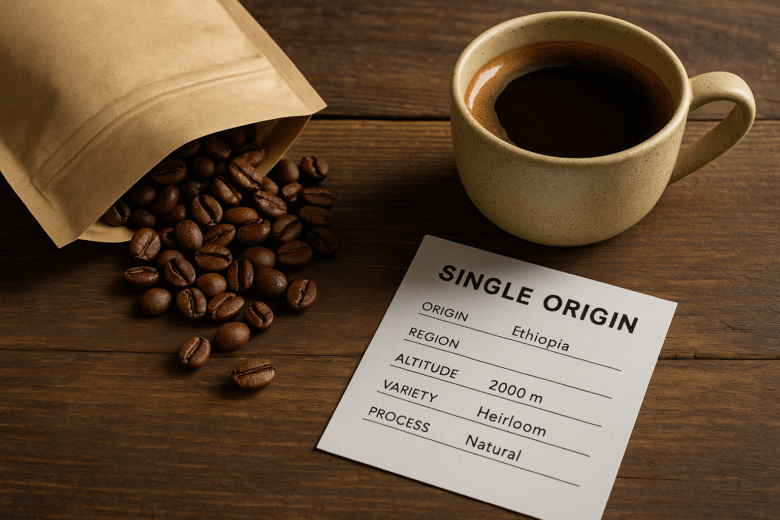In recent years, the term “single-origin coffee” has become a badge of quality in cafés and specialty shops around the world.
You’ll find it on coffee bags, café menus, and even in subscription boxes—often accompanied by specific regions, farms, or even altitudes.
But what does single-origin really mean? And why is it considered such a big deal among coffee lovers?
This article explores what defines single-origin coffee, how it differs from blends, and why it has become a favorite in the world of specialty coffee. By understanding the concept, you’ll be better equipped to choose beans that align with your taste and values.
What Is Single-Origin Coffee?
Single-origin coffee refers to beans that come from a specific geographic location, rather than being blended from multiple sources. That location can be as broad as a country or as specific as a single farm or cooperative.
The more specific the origin, the more traceable and unique the flavor profile tends to be. Some labels even list the farm name, altitude, processing method, and harvest date.
This traceability allows drinkers to explore the unique characteristics that a particular place brings to the bean—what’s known in the coffee world as “terroir.”
How It Differs from Blended Coffee
Blended coffee combines beans from different regions or countries to achieve a specific flavor, body, or consistency. While blends can be delicious and balanced, they tend to mask the distinct qualities of individual origins.
Single-origin coffees are like single-varietal wines. They allow you to taste the full expression of a bean’s origin, influenced by its climate, soil, altitude, and farming practices.
Think of blends as a symphony of instruments, while single-origin is a solo performance—pure, focused, and unfiltered.
Why Single-Origin Coffee Is Popular
The rise of third-wave coffee culture has shifted focus from convenience and branding to transparency, quality, and experience.
Single-origin beans offer:
- A more educational and exploratory approach to coffee
- Greater support for traceable, ethical sourcing
- Opportunities to learn about different regions, farms, and practices
- Distinct flavor notes that change with harvest and location
For many coffee drinkers, this is an exciting way to connect more deeply with what’s in their cup.
Flavor Profiles by Region
One of the most exciting aspects of single-origin coffee is the diversity of flavor. Each origin offers its own signature characteristics.
Ethiopia
Floral, citrusy, tea-like. High-altitude and often naturally processed. Known for heirloom varietals.
Colombia
Balanced, with notes of red fruits, caramel, and chocolate. Often wet-processed for clean acidity.
Kenya
Bright acidity, blackcurrant, tomato-like richness. Dense beans from volcanic soil.
Brazil
Nutty, chocolaty, low acidity. Great for espresso and milk-based drinks.
Guatemala
Spicy, complex, medium body. Notes of cocoa and citrus, especially from Antigua.
Sumatra
Earthy, herbal, full-bodied. Often semi-washed, with low acidity.
By trying single-origin coffees from different countries, you can train your palate to recognize these differences.
The Role of Altitude and Climate
Altitude plays a major role in coffee quality. Higher altitudes usually mean slower bean development, which allows for more complex sugars and acids to form.
This results in brighter acidity, cleaner cups, and more nuanced flavors.
For example, coffee grown at 1,800 meters in Ethiopia might taste floral and light, while coffee from 800 meters in Vietnam could taste stronger and more bitter.
Microclimates—differences in temperature, rainfall, and shade—also influence how beans mature and develop flavor.
Processing Methods Matter
Single-origin coffees often highlight the processing method, because it affects flavor just as much as origin.
Washed (wet) process: Clean, bright, and fruity. Common in Latin America and East Africa.
Natural (dry) process: Sweet, heavy-bodied, with notes of berries or wine. Common in Ethiopia and Brazil.
Honey process: A balance between washed and natural. Sweet with mild acidity. Popular in Central America.
These methods give single-origin coffees another layer of complexity and uniqueness.
Seasonal Availability
Because single-origin coffee is harvested at specific times of the year, availability is often seasonal.
This means:
- Certain origins only appear at specific times
- You may not find your favorite all year round
- Flavor profiles can change slightly from year to year
This seasonality mirrors produce markets and wine vintages—keeping your coffee routine dynamic and rooted in nature’s cycle.
Roast Level and Single-Origin
Many roasters choose to light or medium roast single-origin beans to preserve their unique flavors.
Dark roasts tend to overshadow origin characteristics, making them better suited for blends.
If you’re buying single-origin coffee, opt for lighter roasts to experience the subtleties of that region.
However, some roasters experiment with medium-dark roasts for espresso-friendly profiles without sacrificing clarity.
Single-Origin and Brewing Methods
Some brewing methods better showcase the clarity of single-origin beans.
Pour-over (V60, Chemex): Ideal for light-roasted single-origins. Brings out acidity and aroma.
AeroPress: Great for single-origins with complex notes. Allows control over time and strength.
Espresso: More difficult with single-origin, but rewarding with fruity or chocolatey profiles.
French Press: Works well for medium-bodied origins, like Colombian or Guatemalan.
Choose your method based on the bean’s characteristics and your flavor preferences.
Ethical and Sustainable Sourcing
Single-origin coffee is often associated with direct trade and fair sourcing practices.
Smaller lots from individual farms or cooperatives allow roasters to:
- Pay higher premiums to farmers
- Support environmental sustainability
- Encourage quality improvement
- Build long-term partnerships
As a consumer, choosing single-origin coffee can mean supporting ethical supply chains and encouraging transparency in the industry.
How to Read a Single-Origin Label
A good single-origin coffee bag includes:
- Country of origin
- Region or farm name
- Elevation or altitude
- Variety (e.g., Bourbon, Typica)
- Processing method
- Roast date
These details give you insight into what to expect—and help you compare different beans over time.
The more specific the information, the more likely you’re buying from a specialty or ethical source.
The Cost of Single-Origin
Because of limited availability, labor-intensive practices, and quality control, single-origin beans often cost more than blends.
But that cost reflects:
- Higher wages for producers
- Sustainable farming methods
- Better post-harvest processing
- Fresher, more traceable coffee
Think of it as paying for authenticity, flavor, and fairness—not just caffeine.
Conclusion: Discover the Story in Every Cup
Single-origin coffee is more than a trend. It’s a movement toward transparency, appreciation, and connection.
It lets you explore the world, one cup at a time. It supports farmers and roasters who care deeply about quality and sustainability.
And perhaps most importantly, it transforms coffee from a routine into a story you can taste.
Whether you’re new to coffee or a seasoned enthusiast, exploring single-origin beans is one of the most rewarding parts of the journey.

Marcio Luzardo is a coffee enthusiast and the voice behind Tudo Viraliza. With a passion for turning curiosity into practical knowledge, he shares easy-to-follow tips, guides, and insights to help readers enjoy better coffee every day. When he’s not writing, Marcio is exploring new brewing methods or diving into the rich stories that connect coffee to culture, lifestyle, and wellness.



